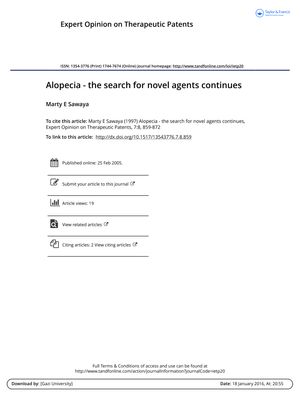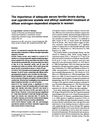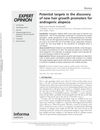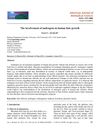Alopecia: The Search for Novel Agents Continues
August 1997
in “
Expert Opinion on Therapeutic Patents
”
androgenetic alopecia 5α-dihydrotestosterone DHT 5α-reductase inhibitors androgen receptor inhibitors steroid-related pathways vascular agents angiogenic agents immunomodulatory agents biochemical pathways Propecia finasteride 4-azasteroid compounds 6-azasteroid compounds carboxylic acid derivatives non-steroid 5α-reductase inhibitors RU58841 cyproterone acetate misoprostol vitamin D analogues human keratinocyte growth factor KGF apoptosis cell proliferation AGA DHT Propecia finasteride RU58841 cyproterone acetate misoprostol vitamin D KGF

TLDR Many potential alopecia treatments need more testing to confirm they promote acceptable hair growth with minimal side effects.
The 1997 document reviews the search for new treatments for alopecia, with a focus on androgenetic alopecia (AGA). It discusses the role of 5α-dihydrotestosterone (DHT) in AGA and the exploration of various drugs, including those not originally intended for hair loss treatment, which often have limited effectiveness and severe side effects. The review mentions nearly 70 patent applications since 1995 for AGA treatments, immunomodulatory related hair diseases, and antichemotherapeutic alopecia agents, targeting mechanisms such as 5α-reductase inhibitors, androgen receptor inhibitors, and other steroid-related pathways, as well as vascular/angiogenic and immunomodulatory agents. It also highlights the importance of understanding biochemical pathways in the scalp. Merck's Phase III clinical trials for Propecia (finasteride) showed hair growth improvement in about 50% of male patients, with trials for women also in progress. The document emphasizes the need for more information on the efficacy and side effects of these treatments. It also discusses various compounds, including 4-azasteroid and 6-azasteroid compounds, carboxylic acid derivatives, non-steroid 5α-reductase inhibitors, androgen receptor inhibitors like RU58841, and cyproterone acetate. Additionally, it mentions potential treatments like misoprostol for chemotherapy-induced alopecia, vitamin D analogues, human keratinocyte growth factor (KGF) 2, and other compounds targeting apoptosis and cell proliferation. The document concludes that while many compounds may be useful for treating alopecia, their efficacy in promoting cosmetically acceptable hair growth or preventing hair loss requires rigorous clinical testing, and treatments should target scalp hair follicles with minimal systemic side effects.








